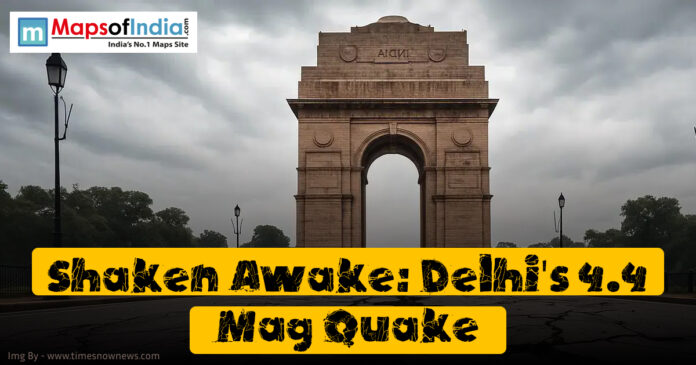On the morning of July 10, 2025, Delhi woke to a jolt. A 4.4 magnitude earthquake struck at 9:04 AM IST. Its epicentre of this quick was near Jhajjar, Haryana, which is 51 km west of the capital. The shock of this quick experience rippled through Delhi-NCR, Noida, Gurugram, and beyond. Residents in this area rushed out of their homes and offices. Social media is flooded with videos and reactions. No damage or casualties were reported after this earthquake. Yet the event stirred fear in a city no stranger to quakes.
The Morning Tremors Hit Delhi-NCR
The earthquake hit the region near Delhi early morning at 9:04 AM. This quake lasted about a minute. Local Residents felt a strong shaking. In houses, Fans swayed, and computer screens trembled. In some places TV mounted on the wall fell. In social media, a man from Gurugram described the ground vibrating while he was drinking the tea. He urged others to run outside. The shocks were experienced in the early morning. At this time, many people are travelling for work and children are going to school. In the nearby area, some felt their vehicle shaking. Local called it “really scary.” Tremors reached Noida, Ghaziabad, Faridabad, and even Meerut, 200 km away from the point. Delhi Metro trains were paused for two to three minutes as a precaution. Social media was bombarded with many posts. One user posted a video of shaking furniture in his house. Another online user called it the “longest earthquake” in years. The National Centre for Seismology (NCS) has confirmed the quake’s details. This earthquake caused panic among people, but no harm was done.
Epicentre and Seismic Details
The epicentre of this quake was 3 km northeast of Jhajjar, which is situated in Haryana. The location of the epicentre is at a depth of 10 km in the Earth. Shallow quakes like this cause more surface shaking. According to the NCS report, the coordinates at 28.63°N, 76.68°E. The Magnitude estimates of this shake vary slightly. Most sources, like India Today, reported this to be a 4.4 magnitude earthquake. Other sources, like India TV, reported a 4.1 magnitude. One of the local Hindi outlets claimed the intensity of the earthquake was 4.8 magnitude. The Richter scale is a scale which is used to measure the intensity of earthquakes. A 4.4 magnitude quake is considered a mild but noticeable one. Delhi’s seismic Zone IV status means frequent tremors. No major faults, like Sohna or Mathura, triggered this event. This quake was likely caused by local stress in weak rock layers. The NCS explained this via their BhooKamp app.
Delhi’s Seismic Vulnerability
Seismic zones are also known as Severe Damage Risk zones. There are four earthquake zones in India, and Delhi is situated in the Seismic Zone IV. This is India’s second highest risk category. The capital city of Delhi lies near the Himalayan fault lines. These fault lines are a result of the Indian plate colliding with the Eurasian plate. This process of plate collision has been ongoing for 50 million years, which is building stress. When that stress is released, it causes earthquakes. Delhi’s flat terrain hides its risk. The extension of the Aravali mountain range from Rajasthan has a ridge toward the city, which adds complexity. According to a recent report by Down to Earth, the links between urban factors to seismic activity are noted. The continuous groundwater extraction has weakened the rocks. It may trigger quakes. Delhi’s fast rising and dense population amplify danger. After the 6.0 magnitude quake in 1960, there has not been a quake above magnitude 5 that has hit this area. Yet it’s not like it won’t happen in future. And the growing density of the city may result in harm from a small rectal scale earthquake. Preparedness is critical.
Public Reaction and Safety Measures
There was a panic everywhere. The time of the quake was in the morning, which caused more panic in residents because most people are getting ready for work and children for school. Those who were in offices and homes came into open spaces to be safe. No harm to any life was caused by this quake, but the quake caused houses to shake. Social media captured this chaos. One user shared a video clip of shaking homes. Memes calling the quake a “natural alarm” were floating online. Delhi Police posted on X, urging people to stay calm. They shared the 112 helpline for emergencies. The National Disaster Response Force issued safety tips. These tips included “drop, cover, and hold on.” Residents were advised to exit to open areas. No injuries occurred, but there was fear among the residents. Public awareness of quake protocols grew.
Previous Quakes near Delhi
Delhi is situated in earthquake earthquake-prone line and has a quake-prone past. A 6.0 magnitude quake struck Delhi in 1960, which was recorded as the strongest in recent history. If we go further back into the past, in 1720, a magnitude 5.5 to 6.7 event caused damage. The 1956 there was 6.7 magnitude earthquake occurred in Khurja, which killed 23 people in Bulandshahr. There are many small scale earthquakes near areas of Delhi that have been noticed sometimes, these quakes have caused harm. In 2022, a 4.1 magnitude quake hit Haryana. Recently, in feb 2025, we saw a 4.0 quake near Dhaula Kuan. In this past decade, there have been 43 earthquakes above magnitude 4 that have struck within 300 km of Delhi. That’s about four each year. No magnitude 6 quakes have occurred since 2017. Delhi’s risk remains high due to its location.
Future Preparedness and Lessons
The earthquake shows Delhi’s need for readiness. The whole Seismic Zone IV need robust planning. The NCS is monitoring activity closely. The app developed by NCS, the BhooKamp app, gives us real-time alerts. Experts suggest stronger building codes. Many older structures can fall with a small shake, they need seismic design. According to the Hindu report, it has been noted that no legal framework enforces these codes. Public education is key to avoiding these naturally born disasters. Residents should know evacuation protocols. Schools and offices need to conduct earthquake drills regularly. Aftershock effects should be handled properly by the authorities. Delhi needs to invest in infrastructure. This earthquake can be taken as a wake-up call. This event highlights the need for better preparation. The city needs to act now and be prepared for what the future holds.




